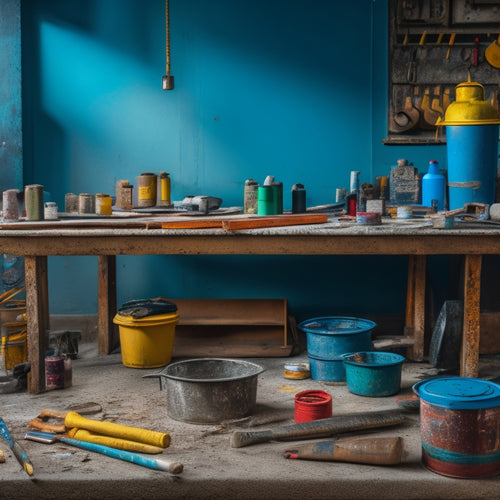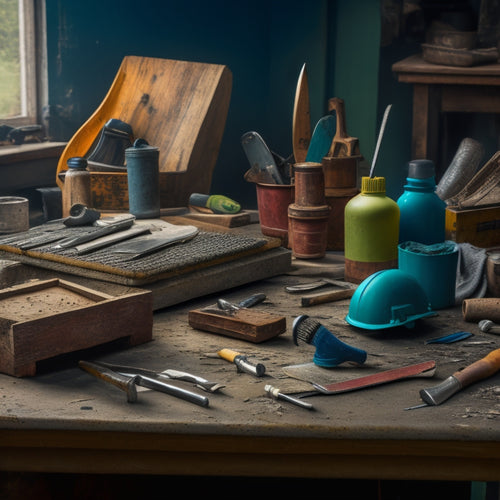
10 Best Tools for Concrete Crack Repair
Share
You'll need a range of specialized tools for a successful concrete crack repair project. Start with essential crack injection tools like a drill, mixer, and injection gun, and guarantee you have the right materials that meet industry standards. High-pressure pumping equipment, epoxy injection guns, and polyurethane foam injectors will help you tackle varying crack sizes and depths. Don't forget surface preparation tools, mixing equipment, and crack filling and sealing tools. Finally, have the right post-repair finishing equipment on hand to achieve a professional-looking result. With these tools, you'll be well-equipped to tackle even the most complex concrete crack repairs - and there's more to learn about each one.
Key Takeaways
• A crack injection tool kit is essential, including a drill, mixer, injection gun, packers, and suitable resin that meets industry standards.
• High-pressure pumping equipment with a pressure rating exceeding 1,000 psi is necessary for effective injection of repair material.
• Epoxy injection guns, polyurethane foam injectors, and sealant application guns are advanced tools for precise material dispensing and control.
• Surface preparation tools, such as wire brushes and grinding machines, are crucial for creating an ideal bonding surface by removing dirt and contaminants.
• Specialized chiseling and scraping tools, like chiseling tools and scrapers, are required for removing deteriorated concrete and ensuring a clean surface.
Essential Crack Injection Tools
You'll need a reliable crack injection tool kit, consisting of at least five essential components, to effectively repair cracks in concrete structures. These components include a drill, mixer, injection gun, packers, and a suitable resin.
When selecting materials, prioritize those that meet industry standards for strength, durability, and resistance to chemicals and environmental factors. It's vital to follow strict safety protocols to prevent accidents and guarantee a successful repair.
Wear protective gear, such as gloves, goggles, and a mask, to minimize exposure to hazardous materials. Make sure the work area is well-ventilated and free from obstructions.
Proper material selection is equally important, as it directly affects the repair's longevity. Choose a resin that matches the concrete's thermal coefficient of expansion to prevent further damage.
High-Pressure Pumping Equipment
To guarantee a successful crack repair, you'll need to move on to the high-pressure pumping equipment, which plays an essential role in efficiently delivering the repair material into the crack. This equipment is designed to handle high-pressure techniques, making certain the material reaches deep into the crack, effectively sealing it.
When selecting high-pressure pumping equipment, consider the pressure rating, flow rate, and material compatibility. Look for equipment with a high pressure rating, typically above 1,000 psi, to make sure the material is properly injected into the crack. Additionally, the flow rate should be adjustable to accommodate varying crack sizes and material viscosities.
Regular equipment maintenance is vital to prolong the lifespan of your high-pressure pumping equipment and prevent costly repairs. This includes routine cleaning, lubricating moving parts, and replacing worn-out seals or O-rings.
Advanced Epoxy Injection Guns
With advanced epoxy injection guns, contractors can accurately dispense precise amounts of epoxy resin into hairline cracks, ensuring a strong and lasting bond. These guns are designed to provide ideal control over the injection process, allowing you to achieve consistent results even in the most challenging applications. By adjusting the injection pressure and flow rate, you can tailor the epoxy delivery to the specific requirements of the crack, ensuring maximum epoxy durability.
When selecting an advanced epoxy injection gun, look for features such as adjustable pressure regulators, precision flow control, and ergonomic design. These features enable you to refine your injection techniques and work efficiently, even in confined spaces.
Additionally, consider guns with interchangeable nozzles and tips, which allow you to adapt to varying crack widths and geometries. By mastering the use of advanced epoxy injection guns, you can take your concrete crack repair skills to the next level and deliver exceptional results that meet the highest standards of epoxy durability.
Crack Cleaning and Preparation
Before injecting epoxy resin, thoroughly clean and prepare the crack to guarantee a strong bond between the epoxy and the concrete, as any dirt, oil, or old repair materials can compromise the repair's integrity.
You'll need to conduct a thorough crack assessment to identify any obstructions or debris that might affect the repair. Use a wire brush or scrubber to remove loose particles, and then vacuum the area to guarantee a clean surface.
If you notice surface dampness, use a desiccant or drying agent to eliminate excess moisture. Next, use a solvent-based cleaner to remove any oils or grease that might be present. This step is vital, as epoxy won't bond well with oily surfaces.
Once the crack is clean and dry, you can proceed with applying a bonding agent to enhance the epoxy's adhesion. Remember to follow the manufacturer's instructions for both the cleaner and bonding agent to achieve the best results.
Polyurethane Foam Injectors
You'll rely on polyurethane foam injectors to precisely dispense expanding foam into the crack, allowing it to fill even the smallest voids and cavities. These injectors are designed to apply polyurethane foam with exacting precision, ensuring a thorough and efficient repair.
One of the key polyurethane benefits is its ability to expand up to 20 times its original volume, allowing it to fill intricate cracks and crevices. When performing foam application, it's crucial to maintain a consistent flow rate and pressure to achieve ideal results.
This is where a high-quality polyurethane foam injector comes in, providing you with the control and precision you need to get the job done right. By using a polyurethane foam injector, you'll be able to accurately dispense the exact amount of foam required, minimizing waste and ensuring a strong, long-lasting repair.
With the right tool and technique, you'll be able to achieve professional-grade results that will stand the test of time.
Specialized Chiseling and Scraping
Tackling concrete crack repair often requires specialized chiseling and scraping tools to remove deteriorated or damaged concrete, allowing for a cleaner surface to apply repair materials.
You'll need to select the right tools for the job to guarantee effective removal of loose concrete and debris.
When it comes to chisel techniques, you'll want to use a combination of precision and finesse to avoid damaging surrounding concrete. Here are some key considerations to keep in mind:
-
Chisel angle: Hold your chisel at a 20-30 degree angle to effectively remove loose concrete without damaging the surrounding area.
-
Scraping methods: Use a scraper or wire brush to remove loose debris and dust from the crack, guaranteeing a clean surface for repair materials.
-
Tool selection: Choose the right chisel or scraper for the job, taking into account the size and depth of the crack, as well as the type of concrete you're working with.
Concrete Surface Preparation Tools
With the deteriorated concrete removed, you're ready to move on to the next essential step: employing concrete surface preparation tools to create an ideal bonding surface for your repair materials. This stage is significant, as it guarantees a strong bond between the existing concrete and the new concrete repair materials.
You'll need to select the right surface preparation tools to achieve a clean, sound, and roughened surface. For effective surface preparation, you'll want to use tools that can remove dirt, oil, and other contaminants, as well as roughen the surface to create a mechanical bond.
Some key tools for this stage include wire brushes, scrub brushes, and grinding machines. These tools will help you remove laitance, a weak layer of cement paste that can compromise the bond between the old and new concrete.
Epoxy and Polyurethane Mixers
When you're preparing to mix epoxy or polyurethane for concrete crack repair, you'll need to choose the right mixer for the job.
You'll want to take into account the type of mixer that best suits your specific application, whether it's a high-speed, high-torque mixer or a slower, more gentle one.
Mixer Types Compared
You'll need to choose between epoxy and polyurethane mixers, each designed to handle specific types of concrete crack repair projects. The right mixer type can greatly impact the efficiency and effectiveness of your repair job.
Epoxy mixers are ideal for structural repairs, as they provide high strength and durability. Polyurethane mixers, on the other hand, are better suited for non-structural repairs, such as filling small cracks and joints.
When selecting a mixer, consider the following key factors:
-
Viscosity: Epoxy mixers typically have a higher viscosity, making them more suitable for thick, structural repairs. Polyurethane mixers have a lower viscosity, making them better for thin, non-structural repairs.
-
Curing time: Epoxy mixers take longer to cure, but provide a stronger bond. Polyurethane mixers cure faster, but may not be as strong.
-
Flexibility: Polyurethane mixers are more flexible, allowing for movement and expansion in the repaired area. Epoxy mixers are more rigid, making them better for static repairs.
Mixing Ratios Explained
Getting the mixing ratio right is critical to achieving a strong, durable bond, as even slight variations can compromise the entire repair process. When working with epoxy and polyurethane mixers, you'll need to precisely measure and mix the resin and hardener to achieve the best ratio. This ratio varies depending on the specific product and manufacturer, so be sure to consult the instructions carefully.
To guarantee accuracy, use a digital scale to measure the components by weight, rather than volume. This will help you achieve a precise ratio, which is especially important when working with epoxy-based products.
When mixing, use a slow, deliberate motion to combine the components, scraping the sides and bottom of the mixing container to guarantee a thorough blend. If you're unsure about the mixing ratio or notice any inconsistencies, don't hesitate to make ratio adjustments.
Crack Filling and Sealing Tools
When you're preparing to fill and seal concrete cracks, you'll need the right tools to guarantee a successful outcome.
You'll want to reach for sealant application guns that can accurately dispense materials into tight spaces, as well as crack injection tools designed to handle varying injection pressures.
Sealant Application Guns
Sealant application guns, designed to streamline the crack filling and sealing process, enable contractors to dispense precise amounts of sealant directly into cracks and joints with minimal waste and mess.
When choosing a sealant application gun, you'll want to take into account the type of sealant you're working with, as different guns are designed for specific sealant types. For example, some guns are better suited for high-viscosity sealants, while others are designed for low-viscosity materials.
When selecting a sealant application gun, keep the following factors in mind:
-
Sealant compatibility: Verify the gun is compatible with the specific sealant type you're using.
-
Application technique: Take into account the application technique you'll be using, such as bead injection or surface sealing.
-
Pressure control: Look for a gun with adjustable pressure control to verify precise dispensing.
Crack Injection Tools
You'll need to move on to crack injection tools, which provide a more targeted approach to filling and sealing cracks, especially when working with larger, deeper cracks or those in high-traffic areas. These tools allow you to inject a sealant or adhesive into the crack, filling it from the inside out. This method is particularly effective for cracks that are difficult to reach or require a high level of precision.
When using crack injection tools, it's crucial to take necessary safety precautions, such as wearing protective gear and making certain the area is well-ventilated. You'll also need to develop a solid understanding of various repair techniques, including the type of sealant to use, the ideal injection pressure, and the best way to mix and apply the material.
Post-Repair Finishing Equipment
Finish off your concrete crack repair job with the right post-repair finishing equipment, which guarantees a professional-looking result that withstands further damage.
The right tools will help you achieve a seamless finish, ensuring the repaired area blends in with the surrounding concrete.
To achieve the best post-repair aesthetics, focus on the following finishing techniques:
-
Sanding: Use a high-grit sandpaper to smooth out the repaired area, feathering it out to the surrounding concrete.
-
Grinding: Employ a concrete grinder to remove any excess material, creating a uniform surface.
-
Sealing: Apply a concrete sealer to protect the repaired area from further damage and staining.
Frequently Asked Questions
Can I Repair Concrete Cracks in Freezing Temperatures?
When you're faced with concrete repair in freezing temperatures, it's important to take extra precautions.
You'll need to verify the concrete is dry and free of ice, as moisture can compromise the repair.
Apply a bonding agent to the crack, then fill it with a cold-weather-compatible epoxy or polyurethane-based sealant.
Allow it to cure according to the manufacturer's instructions before exposing it to water or heavy traffic.
How Do I Choose the Right Epoxy Color for My Repair?
Like a master painter selecting the perfect hue, you're tasked with choosing the right epoxy color for your concrete repair. It's an essential decision, as the wrong shade can be an eyesore.
Consider the repair's aesthetic implications: will it blend with the surrounding concrete, or stand out like a sore thumb?
Verify a seamless match by examining the original concrete's color, texture, and finish.
Then, select an epoxy color that harmonizes with these characteristics, assuring a visually appealing repair that lasts.
Are Concrete Crack Repair Tools Suitable for DIY Projects?
When tackling a DIY project, you'll want to guarantee you have the right toolkit for the job.
Fortunately, many concrete crack repair tools are suitable for DIY projects.
With the right DIY toolkits and repair techniques, you can achieve professional-looking results.
You'll need to choose the appropriate tools for your specific project, such as injection ports, surface sealers, and mixing sticks.
Can I Use Polyurethane Foam for Structural Crack Repairs?
Don't be fooled by polyurethane foam's versatility - it's a siren song for DIY enthusiasts.
While it's great for cosmetic polyurethane applications, you shouldn't rely on it for structural crack repairs.
You're risking your structure's integrity by using a material that's not designed to bear heavy loads or withstand environmental stressors.
Instead, opt for epoxy-based or acrylic-based products specifically designed for structural repairs to guarantee your structure remains safe and secure.
Do I Need to Prime the Concrete Surface Before Applying Epoxy?
Before applying epoxy, you'll need to prime the concrete surface to guarantee a strong bond.
Proper surface preparation methods are essential for effective epoxy application techniques. Clean the area thoroughly, removing any dirt, oil, or old adhesive.
Then, use a wire brush or sandpaper to roughen the surface, creating a solid anchor for the epoxy.
Conclusion
You've got the right toolkit to tackle concrete crack repair like a pro.
But, did you know that the timing of the repair can greatly impact its effectiveness?
Research suggests that repairing cracks within the first year of appearance can reduce further damage by up to 90%.
So, don't wait – get to work with these high-quality tools and give your concrete the best chance of a long, crack-free life.
Related Posts
-

Essential Tools for Painting Concrete Walls
When painting concrete walls, you'll need a range of specialized tools to achieve a professional-looking finish. Star...
-

Must-Have Handheld Tools for Concrete Repair
When tackling a concrete repair project, it is crucial to have the right handheld tools to achieve a professional fin...
-

Essential Tools for Epoxy Concrete Floor Repair
You'll need a thorough arsenal of specialized tools to guarantee a successful epoxy concrete floor repair. Floor prep...


